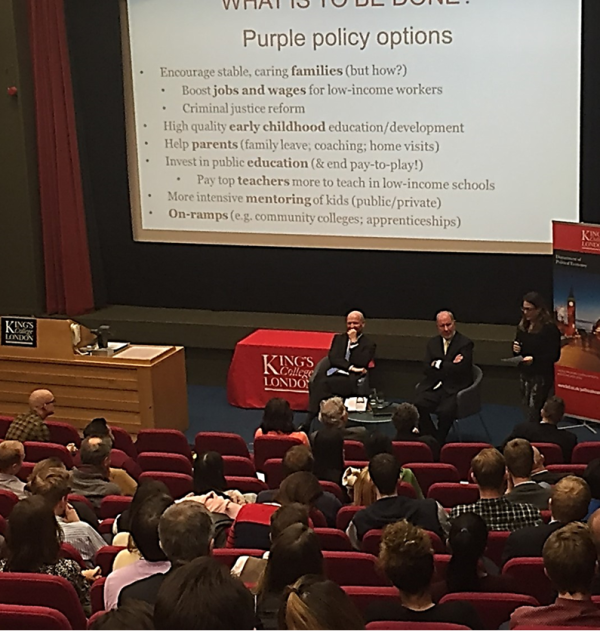Robert Putnam, Harvard Professor and author of Bowling Alone and several other important works, came in to BIT last week to discuss his new book – Our Kids. His latest work reflects on the growing gulf between the lives and expectancies of the rich and poor youth in today’s America. It has already attracted widespread attention in the USA, not least among several of the leading Presidential candidates.
Putnam opens his case by contrasting the greater opportunities available to his grand-daughter with that of the grand-daughter of a lower middle-class schoolmate from his own childhood. Taken alone, it is a shocking contrast. But when situated in his trademark wall of graphs that shows that this example is not a one-off, it is breath-taking.
He shows how the gap has grown across a wide range of measures, not just educational attainment but: time spent with parents; enrichment expenditure; participation in extracurricular; having family dinners together; and even social trust (see last week’s blog). For example: while children with parents from all backgrounds spent a similar amount of time with their parents in the 1960s, today more affluent parents (those with degrees) spend 40 minutes a day more with their children than those whose parents are just High School educated. Over a childhood, that’s roughly a year of full-time attention difference, leaving aside important qualitative differences such as words spoken and quality of interaction, or degree of focus undistracted by other worries.
Given this gulf in experiences, it is perhaps unsurprising to find that the link between children’s test scores at age 11 and their likelihood of getting a degree is swamped by family income. Among high income groups, kids with the top third of test scores at 11 are around 2.5x more likely to get a degree than the lower third of test scores (74% vs 30%); for low income groups, the difference is a gaping 10-fold difference (29% vs 3%). Notably, even the affluent kids with lowest test scores at age 11 are still more likely to get a degree than the smartest poor kids.
Putnam is also a master of standing back from the detail to see the bigger picture. He points out that a swath of variables including income and capital inequality, associational life, intermarriage by class, progressivity of taxation, and so on, all showed a steady rise in the first two-thirds of the twentieth century in the USA, before all falling from the mid-1960s. He argues that something big happened in society that led to these seismic changes. He also notes that the economic indicators lag the social ones, strongly suggesting that the causality runs from socio-political to economic, not the other way around.
It’s tempting in Europe to paint this as an American affliction, but that would be wrong. For example, the time budget data for the last 40 years shows that – at least for the UK – a similar, growing gap in time parents spend with their children, or in social trust by class. We can argue that the more extensive welfare states of Europe take some of the economic consequences out of these differences, but we would be wrong to be complacent. It’s very hard for schools and welfare systems to plug gaps left by intense and sustained differences in parent-child interactions.
Can we identify the subtle social-psychological pathways involved, and to try to do something about them? A glimpse into one such attempt has just been published in a great new special section in Perspectives on Psychological Science, in which APS boldly makes the case for a “Council of Psychological Science Advisors”. It includes pieces on child development, schooling, public health and other issues, each combining latest research with specific policy suggestions.
We have some lines of work within BIT that directly target the idea of ‘life chances’. In collaboration with Todd Rogers (Harvard), for example, we are testing whether nudges can activate wider social networks to provide support, as well as nudges designed to motivate directly. We have found that such prompts can improve test performance and dramatically reduce drop-out and – importantly – are also very welcomed by the young people concerned. Other promising lines of work include: changes in recruitment, ways of helping low income parents be more effective, rainy day savings, and interventions focused on social capital (especially strengthening weak ties) and ‘soft skills’. As Putnam shows, this is an important issue for all of us, whether we have a Council of Psychological Advisers or not.
Robert Putnam at a public event at Kings, chaired by David Willetts, showing his concluding policy options slide. We spent some time discussing these and other policy options with him when he visited BIT.

